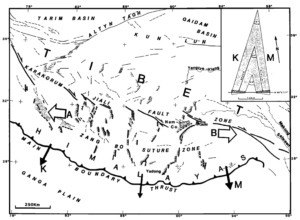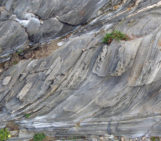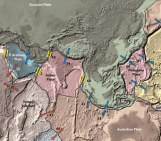
This contribution is a very detailed field report of the Sino-French expedition in eastern Tibet that took place in 1980-1982. Armijo and coauthors accurately analyse the different tectonic styles present in the north and south of the Yarlung-Zangbo Suture Zone, frequently defined as the “chord” joining the eastern and western syntaxes of the Himalayan orogen (Fig. 1).

Figure 1: Kinematics and active faulting of South Tibet and Himalayas. From Armijo et al., 1986.
North of the chord, strike-slip faulting dominates over normal faulting, with rifts being localised at junctions between strike-slip segments and characterised by diffused distribution; south of the chord, a series of N-S–trending normal faults, organised in seven regularly spaced rift zones, display kilometric offsets. The modest E-W extension within the northern section may be balancing the Quaternary N-S shortening, with negligible net crustal thinning, while in the southern section offsets result in a principal E-W-directed extension, with the spreading rate estimated to be 1±0.6 cm/yr.
According to the authors, the differences in extension rates – and hence, the tectonic style – may reflect the different crustal rheologies of these areas: the magmatic and tectonic activity affecting the southern area since 150 Ma resulted in a weaker crust, that fostered the development of major normal faulting, and contrarily, the lack of deformation, except for reactivation only in recent times, since 150 Ma in the neighbouring areas led to a stronger crust. The authors also suggested that the eastern Himalyan syntaxis may represent an obstacle to E-W extrusion south of the chord.
The discussion about Armijo and coauthors (1986) on Reddit, to which Allen Shan, Gino de Gelder, Silvia Crosetto, David Fernández-Blanco, and Marta Marchegiano participated, highlights the impressive details and knowledge characterising this field campaign, which became a solid basis for geologists who later investigated the area. All discussion participants agree on the fact that the beautiful hand-drawn illustrations and the pictures help to follow and visualise every single feature described (Fig. 2), and that the real value of the paper lies in the ability to correlate information across scales.
Field observations and cross-sections were translated to fault activity and rift analysis, ultimately leading to major inferences about the plateau evolution, including extension, thrusting, and extrusion at tectonic scale, about the India-Asia collision, and about the behaviour of their lithospheres.

Figure 2 : Example of hand-drawn sketch representing a suspended glacial valley and a fault plane cutting the slope. (For symbols’ legend, see Armijo et al., 1986)
Indeed, this paper is certainly among the first field-to-lithosphere scale studies in the tectonic geomorphology realm, to the point of placing itself in a cutting-edge ‘geomorphologic tectonics’ approach for that time. This approach and the careful across-scale analyses is somehow still underused today.
Despite a brief reference to crustal flow-influenced fault orientation, the paper makes no attempt to correlate the described lithosphere dynamics with mantle processes, a theme that would be covered in subsequent studies (e.g., Molnar et al., 1993; Willet and Beaumont, 1994). More recent work on this area includes modeling E-W extension by Bischoff and Flesch (2018) and refinement of extension rates by Chevalier et al. (2019).
Written by Marta Marchegiano, Silvia Crosetto, and Gino the Gelder with the TS Must Read team
References
Armijo, R., Tapponnier, P., Mercier, J.L. and Han, T.L., 1986. Quaternary extension in southern Tibet: Field observations and tectonic implications. Journal of Geophysical Research: Solid Earth, 91(B14), pp.13803-13872, https://doi.org/10.1029/JB091iB14p13803
Bischoff, S.H. and Flesch, L.M., 2018. Normal faulting and viscous buckling in the Tibetan Plateau induced by a weak lower crust. Nature communications, 9(1), pp.1-9, https://doi.org/10.1038/s41467-018-07312-9
Chevalier, M.L. and Replumaz, A., 2019. Deciphering old moraine age distributions in SE Tibet showing bimodal climatic signal for glaciations: Marine Isotope Stages 2 and 6. Earth and Planetary Science Letters, 507, pp.105-118, https://doi.org/10.1016/j.epsl.2018.11.033
Molnar, P., England, P. and Martinod, J., 1993. Mantle dynamics, uplift of the Tibetan Plateau, and the Indian monsoon. Reviews of Geophysics, 31(4), pp.357-396, https://doi.org/10.1029/93RG02030
Willett, S.D. and Beaumont, C., 1994. Subduction of Asian lithospheric mantle beneath Tibet inferred from models of continental collision. Nature, 369(6482), pp.642-645, https://doi.org/10.1038/369642a0




